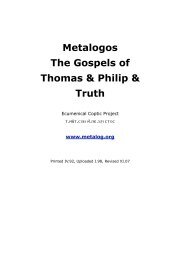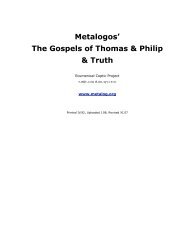Andrew Louth - Syriac Christian Church
Andrew Louth - Syriac Christian Church
Andrew Louth - Syriac Christian Church
Create successful ePaper yourself
Turn your PDF publications into a flip-book with our unique Google optimized e-Paper software.
achieves, not simply union with God, but also fulfils what is the<br />
essentially human role of being the natural bond of all being, drawing<br />
the whole created order into harmony with itself, and into union with<br />
God. 20<br />
But because the human person has not ‘moved around the<br />
unmoved’ (1308C), but on the contrary has directed its power of<br />
movement towards lower creatures that are even less capable<br />
of stillness than itself, it has been sucked into the perpetual,<br />
unsatisfying movement of the fallen universe. Instead of holding in<br />
union what is divided, it has been the cause of separation of what is<br />
united. The universe is now characterized by fragmentation,<br />
disintegration—the corruption leading to death, of which we have seen<br />
St Athanasius had spoken. The only solution is the Incarnation, which<br />
introduces the unmoved into the midst of motion, and thus enables<br />
human beings to reorientate themselves. It is the Incarnation that<br />
now overcomes the five divisions: sexual division through the virginal<br />
conception, the division between paradise and the oikoumenê in the<br />
words from the cross to the repentant thief and in the resurrection<br />
appearances, that between heaven and earth in the event of the<br />
Ascension, that between the intelligible and the sensible by the<br />
enduring reality of the Ascension—the presence of the sacred<br />
humanity in heaven, and that between uncreated and created by his<br />
sitting at the right hand of the Father, that we confess in the Creed.<br />
‘Thus he divinely recapitulates the universe in himself, showing that<br />
the whole creation exists as one, like another human being’ (1312A).<br />
Through the Incarnation it is once again possible for human beings to<br />
fulfil their natural role as bond of creation and microcosm. 21<br />
THE COSMIC LITURGY 22<br />
COSMIC THEOLOGY 71<br />
This notion of the divisions of being occurs elsewhere in Maximus but<br />
it is given particular significance in the first part of his short work on<br />
the Eucharistic liturgy, his Mystagogia. This work falls into three<br />
parts: first, a series of chapters on the symbolism of the <strong>Church</strong><br />
(meaning primarily, though not exclusively, the church building)<br />
(chapters 1–7); second, a series of chapters interpreting the successive<br />
ceremonies of the Byzantine liturgy of his day (chapters 8–21); 23 and<br />
finally three chapters that show how the movement of the liturgy<br />
provides an interpretation of the movement of the individual soul<br />
towards God.<br />
In the introduction, the whole work is presented as something<br />
revealed to him by a ‘blessed old man’ as a complement to the<br />
Ecclesiastical Hierarchy of Denys the Areopagite. In that work Denys<br />
set his whole understanding of the liturgy (not just the Eucharistic




